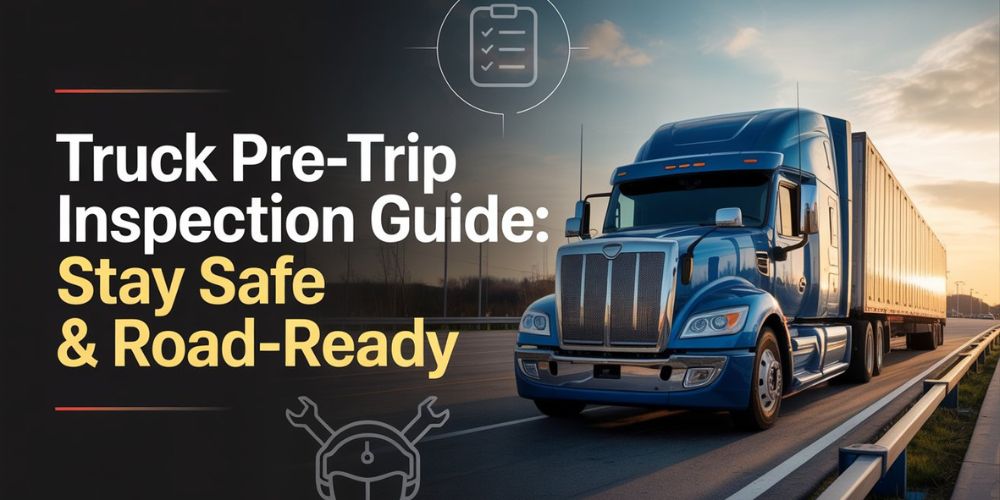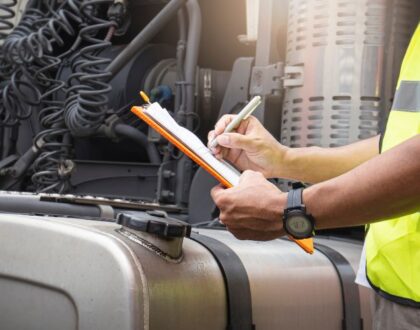Pre-Trip Inspection Checklist: A Comprehensive Guide to Keeping Your Truck Road-Ready

Clean trucks ensure that freight arrives on time and drivers remain safe. A pre-trip check spots small issues before they cause a breakdown. This guide explains why the check is important, lists common problems drivers often encounter, and provides a daily Pre-Trip Inspection Checklist.
Why Pre-Trip Inspections Matter

You must inspect your truck before every shift, as it’s not just simply a “good-to-have” routine, but because the law requires it. Make sure steering, brakes, and lights work as lives depend on them.
Do a full walk-around. It protects your load, prevents fines, and keeps the road safe. Ignoring a defect and a crash will cost insurers about 25% more than if the truck had passed inspection.
Benefits of a Pre-Trip Inspection Checklist
Use a written checklist before every trip. It keeps the inspection quick and consistent. It reminds drivers to check every system. It also records any repairs for officers or shippers. Catching a loose belt early can prevent a costly roadside repair, and fleets that track these checks see fewer violations because everyone knows the rules count.
Common Issues Found During Pre-Trip Inspections
Common issues a pre-trip check often finds:
1. Mechanical
Worn steering parts, misaligned wheel alignment, cracked brake linings, stuck slack adjusters, or broken springs are some of the most important mechanical parts you should take a look at before pumping the gas pedal.
2. Electrical
Dim headlights, missing clearance lights, corroded trailer pigtails, or loose battery cables cut visibility and delay starts.
3. Leaks
If you find leaked oils below where your vehicle was parked, it could be oil, coolant, power-steering fluid, or diesel on the ground. It’s a bad sign, which means a gasket or hose is failing.
4. Loose parts
Exhaust stacks, mud flaps, and cross-members shake loose on rough roads. Missing nuts or cracked welds weaken the frame and drop debris.
Essential Pre-Trip Inspection Checklist

Here are some of the most important pre-trip inspection things you should consider taking a look at:
1. Front of Tractor
Keep the windshield clean and chip-free. Make sure wipers work and the washer tank is full, and turn on both headlight beams. Check that the turn signals and four-way flashers blink, and also confirm that the bumper and license plate are tight.
2. Engine Compartment
Check the oil and tighten the cap, and look for coolant leaks in the tank and hoses. Verify the power-steering fluid is full and the pump looks solid, and the belts must be tight and free of cracks. The steering gearbox should be dry and bolted down. And make sure the water pump and alternator are firmly mounted.
3. Left Side Tractor
Ensure the driver’s door hinges and seal are intact and that the mirror arms are tight with clean glass.
Fuel tank straps, caps, and lines should be secure, and the exhaust system must show no soot streaks with clamps properly fastened. Frame rails and cross-members should not display any bends or cracks.
4. Wheels and Suspension
Check tire tread. Steer tires need at least 4/32 inch, drive tires need 2/32 inch. Keep every tire properly inflated. Rims should not have weld repairs or rust trails near studs, while all lug nuts must be present and secure.
Hub oil levels should be correct, and spring hangers, U-bolts, airbags, and shocks need to be in sound condition.
5. Cab Interior
The parking brake should be set with the gear in neutral, and all gauges must sweep and return to zero during checks.
Make sure both the city horn and air horn work. Test the heater and defroster too. Emergency equipment must include a fully charged fire extinguisher, spare fuses, and warning triangles.
6. Coupling System
Airline glad-hands should have gaskets in place with no leaks, and the electrical pigtail must be seated and locked. The fifth-wheel plate should be greased, with no gap between the jaws and the kingpin.
The release arm must be secure with the safety latch locked, and the landing gear handle should be properly stowed.
7. Trailer Front and Sides
All clearance and marker lamps must work, and the header board should be free of holes. Reflective tape needs to be intact, and side panels should not have bulges or damage that could contact the tires.
8. Rear of Trailer
Trailer doors and hinges should close tightly, while brake lights, tail lamps, and turn signals must operate properly. Check the license plate light. It must turn on. Make sure the ICC bumper is secure.
9. Brake System Check
Air pressure should build to the governor cut-out, and during an applied pressure test at 90 psi, loss must not exceed 3 psi in one minute.
The low-air warning must activate at 55 psi or above, and the tractor-trailer protection valve should pop off between 20 and 40 psi. Finally, gently pull forward to test the service brakes and tug against the trailer brakes to confirm they hold.
Tips for Effective Pre-Trip Inspections
Along with mastering pre-trip inspections, truck drivers must also develop the right mindset and abilities to stay safe and efficient on the road. These essential truck driver skills—from focus and communication to problem-solving—form the foundation of a successful driving career. You can explore our guide on essential truck driver skills to better understand how these abilities work hand-in-hand with daily inspections.
Here are some tips for effective pre-trip inspections:
- Using a Checklist Daily
Read every line, even when the truck is familiar. Skip nothing. Repetition limits mistakes and builds the habit that new drivers learn in Truck Driver Training classes.
- Time-Saving Techniques
You should carry a bright LED flashlight for dawn starts. Start the engine and let the air build while you inspect the lights. Also, park near a wall and watch reflections to spot failed bulbs without an assistant.
- Tools That Help Truckers
You should have a toolkit with the essential tools that can help avoid getting stranded. An angled tire gauge, a brake-stroke stick, a multi-bit screwdriver, a small wrench, and (on the technical side), you must have an inspection app. Put on gloves and knee pads before you crawl under the truck.
Many drivers also rely on mobile apps for navigation, load management, and safety checks. Explore our full list of Essential Mobile Apps for Truck Drivers in 2025 to make sure you’re equipped with the smartest tools on the road.
- Extra Items Worth Adding
Before you roll, make sure the load is tight—check every strap, chain, and seal number. Make sure your registration, insurance, and permits cover the route. Pack seasonal gear too: an ice scraper, rain suit, or sun hat, as needed.
Conclusion
Having a clear pre-trip inspection list all checked out is the very first step of safe, compliant, and profitable hauling. Regular checks catch worn brakes, bad wires, and leaking hoses before they sideline a load. They also prove diligence during roadside stops and shield carriers from costly penalties. Drivers who master inspections reduce stress and protect everyone around them.
The Zenith Institute of Logistics teaches these skills in depth, giving students hands-on practice with real equipment and clear feedback from seasoned instructors. Graduates leave knowing how to perform a detailed Truck Safety Inspection quickly and correctly, every single day. Safety starts before the key turns, and Zenith helps future professionals build that habit with confidence.
Recommended Posts

Six Safety Tips For Truck Drivers
November 29, 2024


